25 Day Spirit of Southern Africa Safari
Help Me Plan- Home
- >
- African Safari
- >
- South Africa
- >
- Spirit of Southern Africa Safari - 25 Days
Summary
Experience a remarkable 25-day journey across Southern Africa’s iconic landscapes, guided in Namibia and Cape Town by an expert African Sky guide, with resident ranger–led experiences elsewhere ensuring seamless exploration, natural insight, and unforgettable encounters throughout a diverse and immersive adventure.
- 1 Night Windhoek
- 2 Nights Sossusvlei
- 3 Nights Swakopmund
- 2 Nights Damaraland
- 3 Nights Etosha National Park
- 1 Night Windhoek
- 4 Nights Cape Town
- 3 Nights Kruger National Park
- 2 Nights Victoria Falls
- 3 Nights Okavango Delta
Price Per Person Sharing From:
From: POAThe price can be reduced by substituting accommodations
What influences prices?
Luxury Southern Africa Safari Itinerary: 25 Day Spirit of Southern Africa
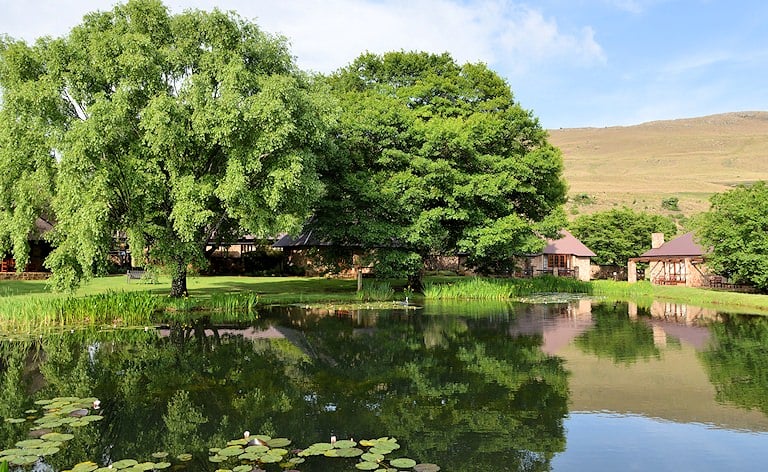
Windhoek
Highlights
- Warm arrival assistance
- Stay at historic Heinitzburg
- Scenic city views
Windhoek
Your journey begins at O.R. Tambo International Airport, where an African Sky representative warmly meets you upon arrival and assists with a smooth transfer to your onward flight bound for Windhoek. Upon landing in Namibia’s capital—set at an elevation of nearly 1,700 meters and framed by the Khomas Highlands—you are met once more and transferred to the elegant Hotel Heinitzburg. This vibrant highland city is known for its welcoming atmosphere, striking German-colonial architecture, and clear desert light, marking the relaxed beginning of your adventure.
Later, unwind at Hotel Heinitzburg, a historic castle built in 1914 and known for its sweeping views over Windhoek’s skyline and surrounding hills. The property is part of Namibia’s early colonial heritage and today blends historic elegance with warm African hospitality. As evening settles across the highlands, relax into the peaceful surroundings and prepare for the remarkable landscapes that await in the days ahead.
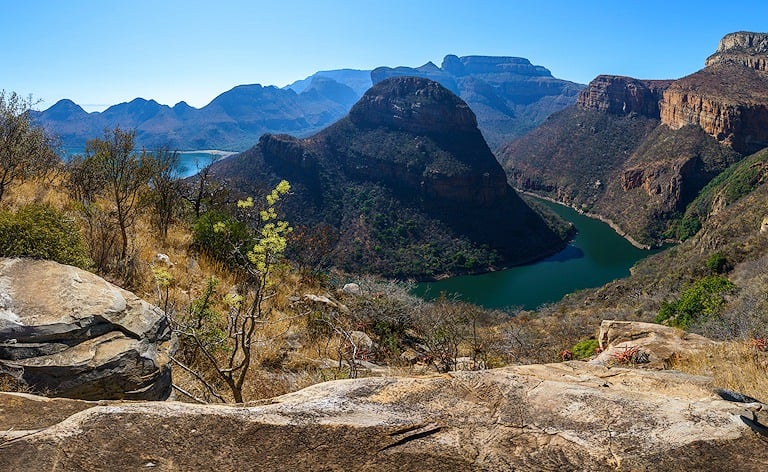
Windhoek / Sossusvlei
Highlights
- Overland desert journey
- Oldest desert landscapes
- Arrival at Kwessi Dunes
Windhoek / Sossusvlei
In the morning, your experienced African Sky guide meets you at Hotel Heinitzburg and begins the overland journey south toward Sossusvlei. The route leads through Namibia’s vast central highlands before descending dramatically toward the Namib Desert—widely considered the world’s oldest desert, with dunes shaped by winds that have blown here for millions of years. Along the way, the shifting terrain highlights the immense geological age and openness of the country.
As you approach the NamibRand Reserve, the scenery opens into sweeping gravel plains, distant mountains, and the soft red dunes that define this region. This private conservation area protects more than 200,000 hectares of fragile desert habitat, creating one of the largest privately managed reserves in Southern Africa. Upon arrival at Kwessi Dunes, settle into the lodge’s tranquil setting and enjoy the quiet beauty of the desert as the afternoon light deepens across the surrounding wilderness.
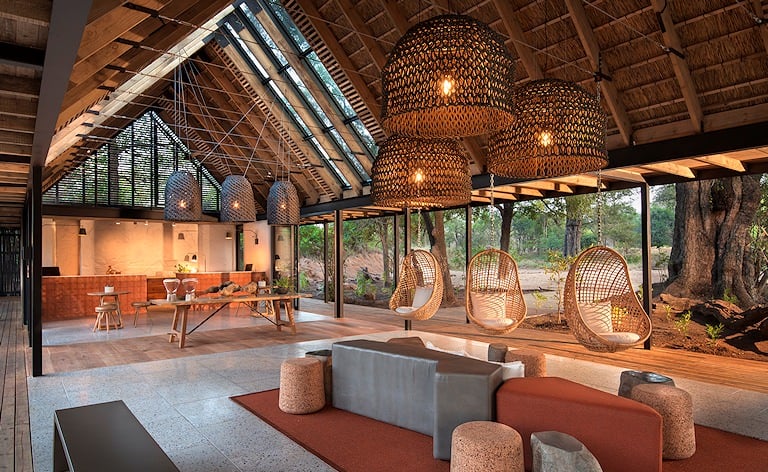
Sossusvlei
-Highlights
- Sunrise Sossusvlei dunes
- Deadvlei clay pan
- Scenic desert drive
Sossusvlei
Today, together with your African Sky guide, you set out early to explore the towering dunes of Sossusvlei, some rising over 300 meters and ranking among the highest in the world. These dunes owe their rich red color to oxidized iron in the sand—an indication of their immense age. Wander across the ancient sands, climb a dune if you wish, and continue to Deadvlei, where centuries-old camel-thorn trees stand in striking contrast against the white clay pan and cobalt sky. Before returning for lunch, we also visit Sesriem Canyon, a narrow gorge carved over millions of years by the Tsauchab River. Its shaded depths offer insight into the desert’s rare but powerful flood cycles.
After returning to the lodge and enjoying a midday rest, you venture out again with your guide on a scenic desert drive through the NamibRand Reserve. This private conservation area is home to oryx, springbok, ostrich, and other species uniquely adapted to life in extreme aridity. As the sun begins to dip, the dunes glow in deep ochres and purples, offering some of the most atmospheric evening light anywhere in Namibia and bringing the desert’s ancient landscapes to life.

Sossusvlei / Swakopmund
Highlights
- Desert-to-coast journey
- Atlantic coastal views
- Swakopmund town exploration
Sossusvlei / Swakopmund
Leave the deep desert behind as we travel toward the Atlantic Coast, crossing rugged mountain passes and sweeping gravel plains along the way. This route showcases the dramatic transition from the Namib’s dune seas to the barren coastal plains shaped by the icy Benguela Current. The presence of this cold ocean current creates the region’s famous coastal fog, which can drift up to 100 kilometers inland and provides vital moisture to desert life.
We spend the afternoon exploring the charming coastal town of Swakopmund at your own pace. Known for its palm-lined promenades, historic German-era buildings, and cool Atlantic breezes, the town offers a refreshing contrast to the desert interior. Whether you choose to browse local craft markets, walk along the shoreline, or relax at your lodge, Swakopmund provides an inviting blend of adventure and seaside tranquility.

Swakopmund
Highlights
- Sandwich Harbour
- 4x4 dune adventure
- Coastal birdlife viewing
Swakopmund
Today brings a full-day excursion to Sandwich Harbour, one of Namibia’s most extraordinary coastal formations where the towering dunes of the Namib plunge dramatically into the Atlantic Ocean. Accompanied by your guide and expert local specialists, travel south along the coast into this remote section of the Namib-Naukluft Park. The area is internationally recognized for its shifting dune cliffs, tidal lagoon, and abundance of birdlife supported by the nutrient-rich Benguela Current, one of the world’s most productive marine systems.
Explore the dune belt and wetlands, learn about the region’s unique desert–ocean ecosystem, and enjoy thrilling 4x4 dune driving in one of the only places on earth where massive sand mountains drop directly into the sea. A scenic picnic lunch is typically enjoyed overlooking the water or dunes. Return to Swakopmund in the late afternoon, enriched by one of Namibia’s most iconic and photogenic coastal experiences.
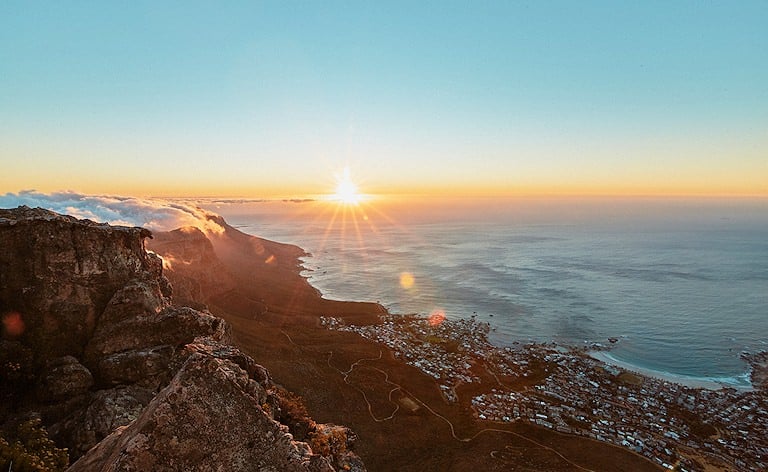
Swakopmund
Highlights
- Guided quad biking
- Desert dune vistas
- Afternoon at leisure
Swakopmund
This morning we set out on an accompanied desert quad biking adventure, guided across the rolling dunes that surround Swakopmund. These coastal dunes form part of the northern Namib sand sea, a UNESCO World Heritage Site. As we navigate the shifting sands, we enjoy sweeping views of the dune belt and learn how specialized desert species—from fog-basking beetles to dune lizards—have evolved remarkable techniques to survive in this arid environment.
The afternoon is spent at leisure in Swakopmund. Wander the palm-lined streets, explore the town’s galleries and coffee shops, or stroll the beachfront promenade where the cold Atlantic swells break against the shore. The town’s distinctive blend of relaxed seaside living and preserved German-colonial architecture offers a refreshing pause before traveling deeper into Namibia’s remote interior.
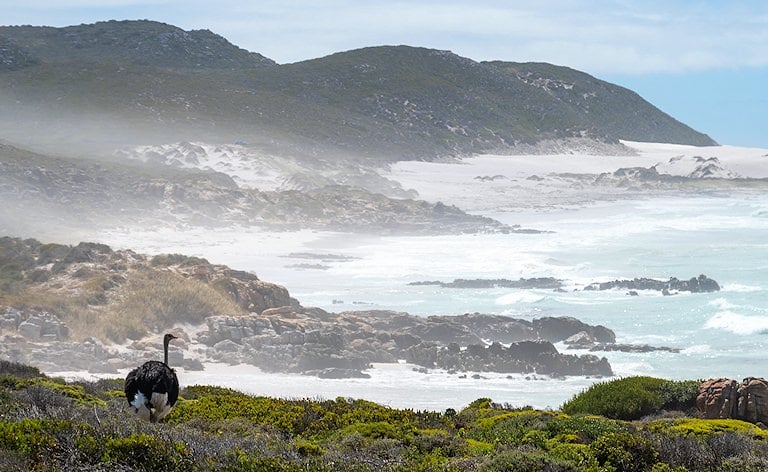
Swakopmund / Damaraland
Highlights
- Cape Cross seal colony
- Skeleton Coast scenery
- Arrival at Camp Kipwe
Swakopmund / Damaraland
We depart Swakopmund in the morning and travel north along the Skeleton Coast, passing shipwreck-strewn beaches and entering one of the most remote coastal regions in Africa. Our main stop is Cape Cross—home to one of the world’s largest Cape fur seal colonies, where up to 200,000 seals may gather during peak breeding season. The site is also historically significant: it marks the landing place of Portuguese explorer Diogo Cão, who erected a stone cross here in 1486 during early European exploration of the African coastline.
After our visit, we continue inland toward Damaraland, where the landscape transitions from stark coastal plains to rugged mountains, dry riverbeds, and vast open spaces shaped by ancient geological forces. Along the way we enjoy impressive desert scenery before arriving at Camp Kipwe in the late afternoon. Built among clusters of massive granite boulders, the camp blends seamlessly into its surroundings and offers a truly atmospheric base for exploring this ancient region.

Damaraland
Highlights
- Twyfelfontein rock art
- Desert-adapted wildlife
- Damaraland desert vistas
Damaraland
We spend a full day exploring the remarkable natural and cultural heritage of Damaraland. Accompanied by our guide, we begin with a visit to Twyfelfontein—Namibia’s first UNESCO World Heritage Site and one of the largest concentrations of rock engravings in Africa. This sandstone valley contains more than 2,500 engravings created by San hunter-gatherers up to 6,000 years ago, depicting wildlife, tracking symbols, and spiritual motifs that offer a rare glimpse into the cultural traditions of early desert inhabitants.
Later, we explore other highlights of the region, which may include the Organ Pipes basalt formations, the color-shifting slopes of Burnt Mountain, or a scenic drive through the Aba Huab River valley in search of desert-adapted elephants. These elephants have developed unique behaviors that allow them to survive in extremely arid conditions, often walking long distances between ephemeral water sources. We return to Camp Kipwe in the late afternoon, where the warm granite boulders glow beautifully in the setting sun.

Damaraland / Etosha National Park
Highlights
- Scenic overland transfer
- Ongava private reserve
- Afternoon game drive
Damaraland / Etosha National Park
We depart Camp Kipwe in the morning and travel overland toward Etosha’s southern boundary, following a route that reveals the shifting character of northern Namibia. The journey takes us from Damaraland’s rugged inselbergs and dry riverbeds into the more vegetated savannas of the Kunene Region. This gradual transition marks the approach to Etosha National Park, one of Africa’s premier wildlife reserves and centered around a vast salt pan visible from space.
By early afternoon we arrive at Ongava Lodge, situated on a private reserve bordering Etosha. Ongava is recognized for its pioneering conservation work, including successful rhino protection and habitat management programs. After settling in, we join an afternoon game activity on the reserve, where sightings often include both black and white rhino, as well as lion, giraffe, and numerous plains species. As the sun sets across the bushveld, Ongava reveals its rich wildlife and peaceful wilderness atmosphere.

Etosha National Park
Highlights
- Ranger-led game drives
- Etosha salt pan vistas
- Rhino viewing chances
Etosha National Park
The next two days are devoted to exploring Ongava Reserve and neighboring Etosha National Park, with morning and afternoon activities led by the lodge’s experienced resident rangers. Etosha’s immense salt pan, covering around 4,800 square kilometers, creates a unique ecosystem that attracts tens of thousands of animals to its surrounding waterholes during the dry season. Game drives traverse open plains, mopane woodlands, and grasslands where large herds of zebra, springbok, and wildebeest gather under Namibia’s expansive skies.
During these days, guests also have the option to enjoy guided nature walks on the Ongava Reserve, one of the few places in Africa where both black and white rhino can be seen in the same habitat. These walks provide a more intimate and educational experience, highlighting animal tracks, geological features, and smaller desert species often missed from a vehicle. Evenings unfold at the lodge’s floodlit waterhole, where wildlife frequently visits after dark, creating a serene and memorable end to each day.
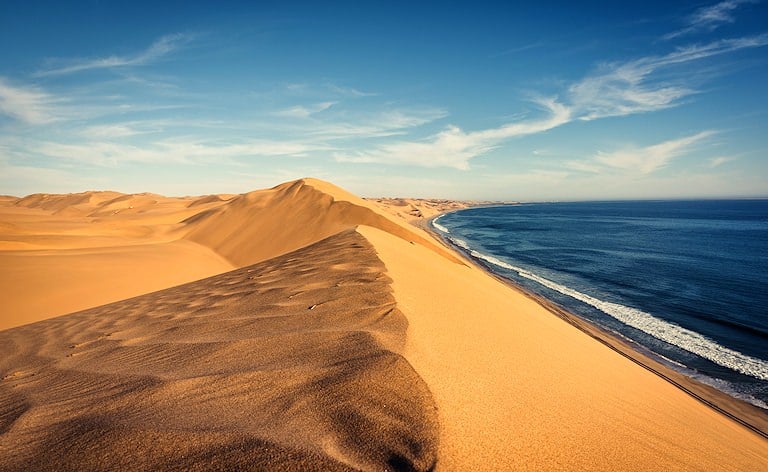
Etosha National Park / Windhoek
Highlights
- Last Etosha sightings
- Overland return drive
- Sunset at Heinitzburg
Etosha National Park / Windhoek
After a final morning in Ongava’s peaceful surroundings, travel overland toward Windhoek, passing through a patchwork of small rural settlements, open rangelands, and the broad, rising landscapes of central Namibia. This route highlights the transition from the wildlife-rich northern regions back into the highland plateau, where the country’s agricultural heartland begins to appear alongside sweeping, open vistas.
Arriving in Windhoek in the late afternoon, the remainder of the day is spent at leisure. Settle back into the comfort of Hotel Heinitzburg, enjoy panoramic views over the city’s hilltops, or savor a quiet evening reflecting on Namibia’s breathtaking diversity—from ancient deserts and sculpted dunes to remote coastal plains and wildlife-filled savannas.
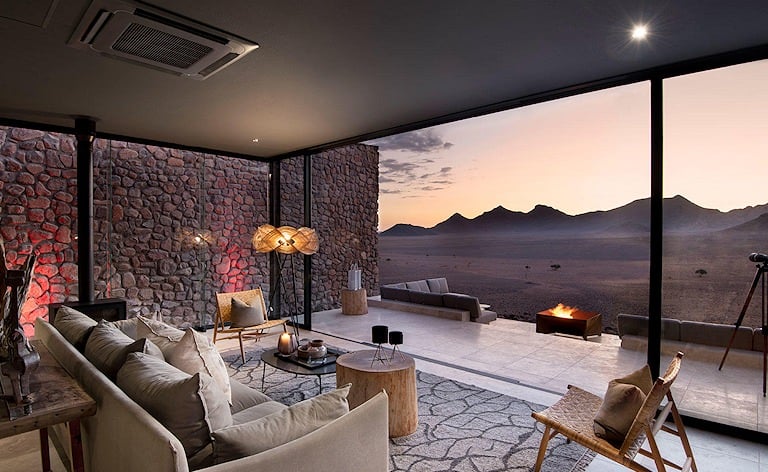
Windhoek / Cape Town
Highlights
- South Africa's Mother City
- Table Bay sunset cruise
- Relaxed arrival evening
Windhoek / Cape Town
After breakfast, transfer to Windhoek Airport for your scheduled flight to Cape Town. On arrival at Cape Town International Airport, an African Sky representative meets us and provides a warm, seamless welcome to South Africa’s Mother City. From here we are transferred to the hotel for check-in and an afternoon of relaxation. Cape Town is known for its dramatic setting beneath Table Mountain and is consistently ranked among the world’s most beautiful cities, offering a remarkable blend of coastal scenery, vibrant culture, and refined hospitality.
In the late afternoon, we head to the V&A Waterfront to board a leisurely Table Bay sunset cruise. As the vessel glides along the coastline, enjoy panoramic views of Table Mountain, the Twelve Apostles, and the city skyline bathed in golden evening light. This tranquil cruise offers a perfect introduction to Cape Town’s maritime charm and provides a memorable start to the next chapter of your Southern African journey.
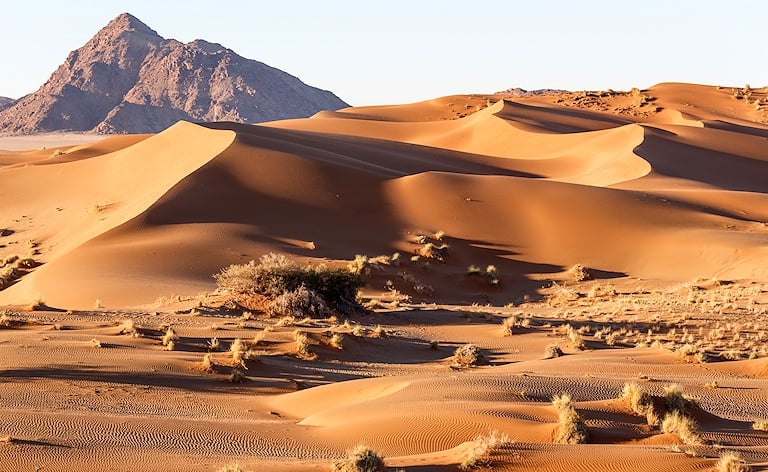
Cape Town
Highlights
- Chapman’s Peak Drive
- Cape Point viewpoints
- Boulders penguin colony
Cape Town
Today we set out with our African Sky guide on a full-day excursion to the Cape Peninsula, one of South Africa’s most iconic coastal journeys. The route follows the spectacular Chapman’s Peak Drive—often regarded as one of the most scenic coastal roads in the world—winding between sheer cliffs and the Atlantic Ocean. Along the way we stop at scenic viewpoints to appreciate the dramatic meeting of rugged mountains, turquoise bays, and kelp-fringed shores that define this unforgettable stretch of coastline.
Continuing into the Cape of Good Hope section of Table Mountain National Park, we visit Cape Point, a dramatic headland known for its soaring cliffs, rich maritime history, and sweeping ocean vistas. In the afternoon we stop at Boulders Beach, home to a resident colony of African penguins, one of only a handful of land-based penguin colonies in the world. Strolling along the boardwalks offers an up-close look at these charming, endangered birds in their natural coastal habitat before returning to the city in the late afternoon.

Cape Town
Highlights
- Table Mountain ascent
- Scenic city panoramas
- Kirstenbosch garden walk
Cape Town
This morning we set out together to explore two of Cape Town’s most iconic natural landmarks, beginning at the foot of Table Mountain. Weather permitting, we ascend by cableway, the rotating cabin offering sweeping views of the city, Table Bay, and the rugged chain of the Twelve Apostles. At the summit, gentle pathways lead us across the flat-topped plateau, surrounded by rare fynbos vegetation—part of the UNESCO-protected Cape Floral Region, the most biodiverse plant kingdom on Earth.
After descending the mountain, we continue to Kirstenbosch National Botanical Garden, regarded as one of the finest botanical gardens in the world. Nestled against the eastern slopes of Table Mountain, its expansive grounds showcase an extraordinary collection of indigenous flora, from towering cycads to colorful proteas. We wander through forested glades, open lawns, and fragrant plantbeds, and enjoy the elevated Boomslang Canopy Walkway before returning to the hotel for a relaxed afternoon.

Cape Town
Highlights
- Franschhoek valley vistas
- Estate wine tastings
- Historic vineyard settings
Cape Town
Today we venture into the celebrated Cape Winelands, accompanied as we set out toward the Franschhoek Valley—often described as the culinary and wine capital of South Africa. Established by French Huguenot settlers in the late 17th century, the valley retains much of its historic charm, with elegant Cape Dutch homesteads, manicured vineyards, and dramatic mountain amphitheaters creating one of the most picturesque wine regions in the world. The journey into the valley offers breathtaking views of rolling vineyards framed by rugged granite peaks.
We spend the day exploring a curated selection of Franschhoek’s renowned wine estates, sampling world-class varietals and learning about the region’s unique terroir, which benefits from cooler mountain influences and rich, fertile soils. Between tastings, we enjoy time to wander historic cellars, appreciate estate gardens, or take in sweeping views across the valley. Whether savoring crisp sauvignon blancs, elegant chardonnays, or Franschhoek’s signature méthode cap classique sparkling wines, the day blends scenic beauty with exceptional culinary and cultural heritage before returning to Cape Town in the late afternoon.<

Cape Town / Private Kruger Park Concession
Highlights
- Flight to Kruger region
- Lodge check-in
- Afternoon game drive
Cape Town / Private Kruger Park Concession
This morning you are transferred to Cape Town International Airport, where we receive assistance with check-in for a scheduled flight to Kruger Mpumalanga Airport. Upon arrival in the Lowveld—a region known for its warm climate, granite hills, and rich biodiversity—you are met and transferred overland to Lukimbi Safari Lodge, located within a private concession in the southern sector of Kruger National Park. The journey introduces you to the park’s classic landscapes of savanna, riverine forests, and rugged outcrops.
After settling into the lodge, an afternoon game drive in an open 4x4 vehicle is enjoyed. This area of Kruger is renowned for excellent Big Five viewing, with frequent sightings of elephant, lion, rhino, and large herds of plains game drawn to the fertile valleys and waterways. As the sun dips behind the escarpment, the bush comes alive with evening sounds, offering a spectacular introduction to safari life before returning to the lodge for dinner.

Private Kruger Park Concession
Highlights
- Morning & afternoon safaris
- Guided bush walks
- Big Five viewing
Private Kruger Park Concession
These days are devoted to immersive safari experiences at Lukimbi, accompanied by the lodge’s highly skilled resident rangers and trackers who share their deep knowledge of the Kruger ecosystem. Morning and afternoon game drives explore a diverse landscape of open grasslands, riverine thickets, and granite outcrops, offering exceptional opportunities to encounter the Big Five as well as cheetah, hyena, and an impressive array of birdlife. The southern region of Kruger is especially renowned for its density of wildlife, making every drive a rewarding and memorable adventure.
Between drives, we have the option to join guided bush walks—an intimate way to discover the smaller wonders of the African wilderness. These walks highlight animal tracks, fascinating insects, medicinal plants, and subtle signs of the bush that are often overlooked from a vehicle. Afternoons provide time to relax at the lodge, enjoy views over the river, or simply soak in the quiet rhythms of the natural environment. Evenings conclude with dinner and time around the fire, listening to the distant sounds of the nocturnal bush.

Private Kruger Park Concession / Victoria Falls
Highlights
- Flight to Zimbabwe
- Waterhole lodge views
- Relaxed afternoon arrival
Private Kruger Park Concession / Victoria Falls
After a final morning in Kruger’s tranquil surroundings, you are transferred to Kruger Mpumalanga International Airport for our flight to Victoria Falls. Upon arrival in Zimbabwe, warm hospitality and the humid subtropical air of the Zambezi Valley provide an immediate shift in atmosphere. You are met at the airport and transferred to Victoria Falls Safari Club, a stylish property set above a wildlife-rich waterhole on the edge of town, offering sweeping views across the surrounding wilderness.
The remainder of the afternoon is spent settling in and enjoying the lodge’s elevated vantage points, where elephant, buffalo, and other animals often wander in to drink. As evening approaches, we may choose to relax on the viewing deck or enjoy a sundowner while the African sky shifts into deep golds and reds. This peaceful introduction sets the stage for tomorrow’s exploration of the world-famous waterfall.
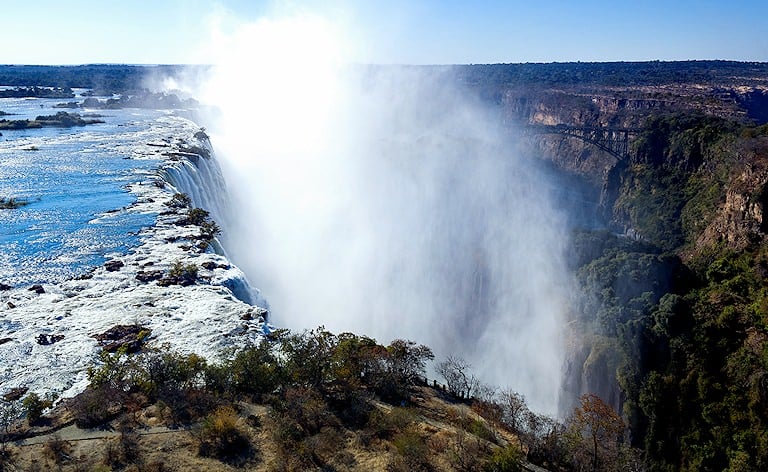
Victoria Falls
Highlights
- Guided Falls tour
- Rainforest viewpoints
- Zambezi sunset cruise
Victoria Falls
This morning we set out to discover the magnificent Victoria Falls on a guided visit through the rainforest pathways that curve along the edge of the gorge. Known locally as “Mosi-oa-Tunya”—the Smoke that Thunders—the Falls span more than 1,700 meters, making them the widest curtain of falling water in the world. As we explore a series of viewpoints, we experience the spray rising like mist, hear the thunderous roar echoing through the forest, and take in dramatic vistas of the Zambezi River plunging into the depths below.
In the late afternoon, we board a leisurely sunset cruise on the Zambezi River, drifting along calm waters upstream of the Falls. This is one of the most tranquil ways to experience the river, with opportunities to spot hippos, crocodiles, and elephants along the shoreline. As the sun sinks into the horizon, the sky turns shades of gold and amber, creating a spectacular end to the day before we return to the lodge for a relaxed evening.

Victoria Falls / Okavango Delta
Highlights
- Transfer to Kasane
- Scenic light aircraft flight
- Arrival in the Delta
Victoria Falls / Okavango Delta
After breakfast, we depart Victoria Falls and travel across the border to Kasane, a small town positioned at the meeting point of four countries and known as a gateway to the Chobe and Okavango regions. The drive offers views of teak forests and riverine landscapes before we arrive at Kasane Airport for our light aircraft transfer into the heart of the Okavango Delta—one of the world’s largest and most pristine inland waterways.
The scenic flight provides a stunning aerial perspective of the Delta’s mosaic of channels, islands, floodplains, and palm-dotted wetlands. As we descend toward our camp, we may spot elephants, giraffes, or even hippos moving through the waterways below. Upon landing, we settle into our lodge and embrace the peaceful rhythms of Delta life, surrounded by some of Africa’s most untouched wilderness.
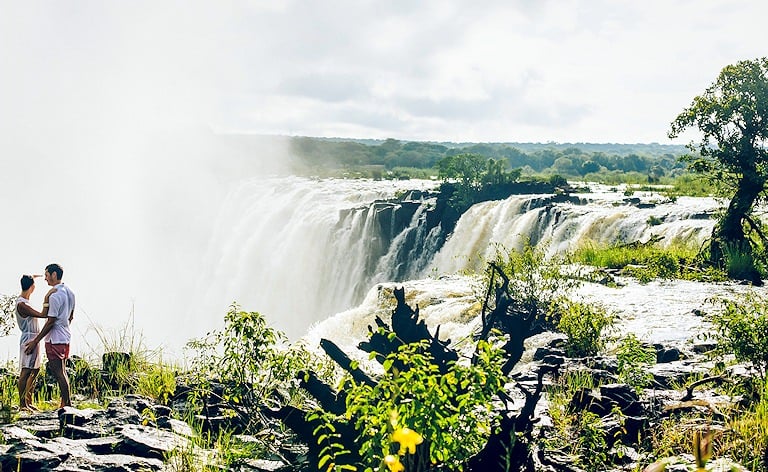
Okavango Delta
Highlights
- Mokoro & boat outings
- Delta game drives
- Exceptional wildlife viewing
Okavango Delta
These days are dedicated to exploring the Okavango Delta, accompanied by the camp’s experienced resident guides who reveal the intricate rhythms of this remarkable ecosystem. Depending on water levels, we set out on a mix of activities that may include traditional mokoro excursions, motorboat outings, or game drives across the surrounding floodplains. The Delta’s rich biodiversity supports elephants, red lechwe, giraffes, buffalo, hippos, and an extraordinary variety of birdlife, creating a safari experience unlike anywhere else on the continent.
Between excursions, we enjoy the tranquility of camp and the ever-changing views of the waterways and lagoons. Afternoon activities may take us deeper into the channels to watch elephants bathing or to track predators moving between islands. As sunset transforms the Delta into hues of gold and rose, we return to camp for dinner under the stars, accompanied by the distant calls of nocturnal animals and the gentle chorus of frogs along the water’s edge.

Departure
Highlights
- Scenic flight to Maun
- Flight to Johannesburg
- End of Southern Africa journey
Departure
After a final morning in the tranquility of the Delta, we board a light charter flight to Maun, enjoying one last aerial view of the waterways, floodplains, and wildlife that make this region so extraordinary. Upon arrival in Maun, we connect with our scheduled flight to Johannesburg, marking the beginning of our journey homeward.
As we arrive in Johannesburg, our unforgettable Southern African adventure comes to an end—rich with memories of vast deserts, dramatic coastlines, world-class wildlife encounters, and the remarkable diversity of cultures and landscapes experienced along the way. Departure follows with a heart full of the magic that defines this extraordinary part of the world.
Included
- 1 Night Hotel Heinitzburg
- 2 Nights Kwessi Dunes
- 3 Nights Desert Breeze Lodge
- 2 Nights Camp Kipwe
- 3 Nights Ongava Lodge
- 1 Night Windhoek
- 4 Nights Commodore
- 3 Nights Jock Safari Lodge
- 2 Nights Victoria Falls Safari Club
- 3 Nights Xakanaxa Camp
- Private African Sky Guide: From Day 1-17
- Resident Rangers: From Day 2-4
- Resident Rangers: From Day 7-12
- Private Activities: From Day 20-22
- Resident Rangers: From Day 22-25
- Private Air Conditioned Vehicle: Day 1-17
- Open 4x4 Vehicle: From Day 2-4
- Private Air Conditioned Vehicle: From Day 7-12
- Open 4x4 Vehicle: From Day 22-25
- Only Meals Specified
- Johannesburg to Windhoek
- Windhoek to Cape Town
- Cape Town to Skukuza
- Nelspruit to Victoria Falls
- Kasane to Xakanaxa Camp (Light Aircraft)
- Xakanaxa Camp to Maun (Light Aircraft)
- Maun to Johannesburg
- Skukuza Airport to Jock Safari Lodge
- Jock Safari Lodge to Nelspruit
- Victoria Falls Aiprort to Victoria Falls Safari Club
- Victoria Falls Safari Club to Kasane
- All Activities Included in the Itinerary, Unless Stated as Optional
- All Entrance Fees to Places Mentioned in the Itinerary, Unless Stated as Optional
- Tourism Levy
- All Applicable Taxes
- All Park Fees, Where Applicable
Excluded
- International Airfare (To and From South Africa)
- Personal and Medical Insurance
- Drinks
- Gratuities
25 Day Spirit of Southern Africa Safari










